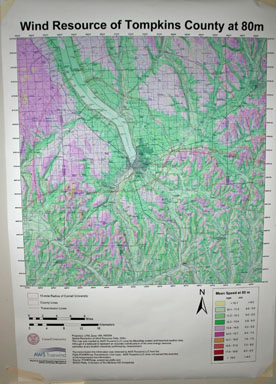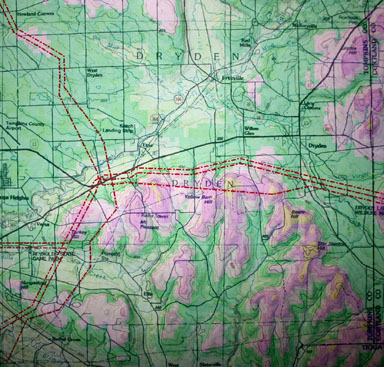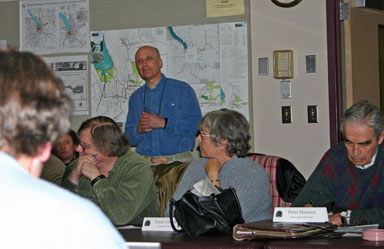April 19, 2005
Windmills generate controversy
Cornell's proposed windmills on Mount Pleasant, near the WHCU radio tower, encountered a lot of opposition last week. I missed the informational meeting at the Varna Community Center, so I went to the Environmental Management Council meeting last Wednesday instead. The Council seemed surprised at how full the room got, and a lot of the people attending weren't very happy. I'll start with the opening of the meeting, and cover the rest of the meeting and comments at last Thursday's Town Board meeting in follow-up stories.
At the beginning of the meeting, they posted maps showing wind energy potential in Tompkins County from AWS Truewind, the consultant Cornell hired to do modeling for the project.

Wind energy potential in Tompkins County (pink is more potential).

Wind energy potential in the Dryden area (pink is more potential, red is powerlines).
The EMC chair reminded the audience that there was a seat open from the Town of Dryden, and then let people speak for one minute at the start of the meeting. Linda Lavine, of Ringwood Road, told the council that:
Relatively speaking, Mount Pleasant is my back yard. It's a place that people in our neighborhood use for walking and for meditating, and for going to watch stars in a beautiful silent place - it's a fairly sacred space for us in many ways in our neck of the woods. In addition to being truly the back yard and the front yard of a fair number of people who live on Mount Pleasant. While wind power seems like a marginally good idea at this point in terms of energy efficiency, this is not the place to put it at all. Somebody at the Varna meeting jokingly suggested to put it on the Newman Golf Course instead, and that seemed about as appropriate as putting it in Mount Pleasant.
Mount Pleasant has an astronomy lab that is used, it has major migratory paths for birds, for hawks. It's a beautiful place that in effect is a kind of sanctuary as it stands, a sort of time out place that hasn't changed in a long time, it's very magical, and it would be a great crime environmentally to destroy it by putting in 400-foot high noisy towers which apparently are very unproven in terms of their environmental impact on people.
I noticed in today's paper the photograph that was in the background for announcing this meeting had the absurd picture that I assume was provided by the people who really stand to gain by this, which is the company that makes the equipment that they sell to set up the towers, and that's a picture of a giant cow with teeny-tiny little towers. In fact, that picture we determined in Varna was quite an insult. These are 400-foot towers, so it's a very inappropriate image. This is not a cute little Dutch windmill, this is a major energy - you might as well make it an oil pump.
Next up was Lavine's husband, Buzz:
One thing I'd want to point out here - well, two things - one is that there's an economic or financial incentive for this stuff which has nothing to do with the broader economy. There is also an energy analysis on this which is yet to be done, really... When I first started off this project, as an environmental planner, I said to myself "what a great idea," but as I started looking into it more and more, I began to think more and more negatively about it, and at this point I am definitely against it.
Partly it's because of the tax subsidies and the renewable energy subsidies - there's a whole separate economy just for those certificates - and that adds a lot of value to it for the people who own it or run it, which has nothing to do with the value to the general society. That might be okay if indeed it was an environmentally sound and just as important, energetically sound. I used to do energy analyses back when I was researching these things and this was a little over 20 years ago, but at that time, wind generation was a major net energy loser. I know there are systems - at least I expect the systems from what I have seen of them have gotten to be better in terms of their net energy production, but a net energy loser means that... if you look at all the indirect energy cost to make the system, make it run, and keep it going, it costs more energy than you get out of it. In an energy production system that's obviously something you don't want to do...
Modern systems may have a better net energy but they have an awful long way to go, and they're not as good in net energy as other alternatives that we have, and consequently other sites for this would be much better if you want to look at it as an experimental thing.

Buzz Lavine addresses the Environmental Management Council.
After Lavine spoke, John Semmler, of Mount Pleasant Road, spoke:
This project is in my front yard, back yard, and both side yards. I'm totally surrounded by Cornell. We moved to where we live in large part because of the natural beauty of the environment on Mount Pleasant. It's just a wonderful area. If you haven't driven up Mount Pleasant Road on a day like today, it's a gorgeous gorgeous scene. I consider myself an environmentalist. I've often thought about a wind turbine for my own home, but I quickly realized that would be about a quarter of the size of the project that we're talking about here for Cornell.
I went up to Fenner to take a look, thinking maybe there's something here that I don't understand. Fenner has, I think, the largest wind energy site in New York State as well as in the northeast. I found it very discouraging. The units are mammoth, just incredibly large. They make at least four different kinds of noise:
- The sound of the rotors going around;
- the sound of the generator that's on top of the pole that they sit on, a humming noise like a fluorescent light or a refrigerator;
- a screeching kind of a noise when the unit turns to face the wind;
- and a noise that I think most of us will never hear, and that's the sound of when the brake goes on because the wind is going over 55 miles an hour, which is I think the speed they have a governor which causes them to stop.
In any event, one is so close to my house that I'd be able to throw a stone and hit it, and my wife and I and our family feel that we just wouldn't be able to live there under those kinds of conditions.
Howard Evans of Turkey Hill Road also spoke:
I'm not as close as John Semmler is to this, but what I wonder about is really the noise. I was at a wind field in Hawaii, where one of the problems was the blades flying off it every once in a while. Maybe that doesn't happen any more, but that's a consideration. The other thing is the constant humming and the noise. I think even where I live on Turkey Hill that I would hear the noise. Perhaps the situation has improved greatly, but I think we ought to think about that.
The EMC turned to other business for the next forty minutes until Lanny Joyce of Cornell arrived, which I'll cover in a story tomorrow.
- Citizen comments on wind power
- Cornell's perspective on wind power
- Questioning Cornell about wind, Part 1
- Questioning Cornell about wind, Part 2
- Wind farm discussion at April Town Board meeting.
Note on photos